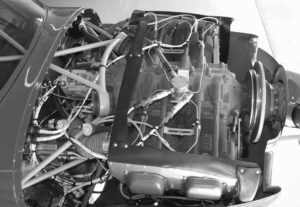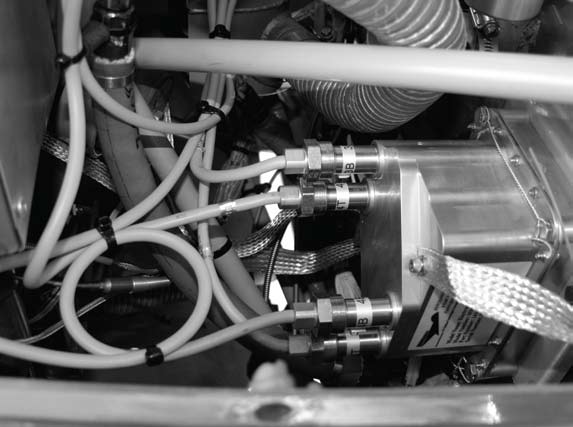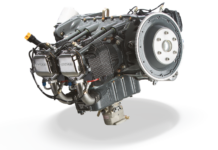For those of you who are interested in the Aerosance FADEC system, I thought I would give some insight in my fairly extensive experience with the system.
 I have installed the FADEC system in both my GlaStar and my Sportsman airplanes. I have about 120 hours of time on the Sportsman and there have been about 300 hours of time on the GlaStar between myself and Paul Oswald who is the new owner.
I have installed the FADEC system in both my GlaStar and my Sportsman airplanes. I have about 120 hours of time on the Sportsman and there have been about 300 hours of time on the GlaStar between myself and Paul Oswald who is the new owner.
The system uses 4 computers to control the fuel and timing with sequential port fuel injection and variable electronic ignition. It gives about 15-20 percent better fuel consumption by operating lean of peak and individually controlling all the needs of each cylinder, and about 5% better power by giving a better stoichiometric mixture. With both aircraft, before FADEC, I was burning around 10 gph in fast cruise and with the FADEC, I burn around 8 gph at the same settings.
There is no longer a mixture control and the computers control all the engine parameters. They interface engine data with both the VM 1000 and the Blue Mountain Avionics synthetic vision system.

Initially, I had a fuel injected IO-360 with the GlaStar and a regular O-360 with the Sportsman. The fuel injection is a little better than the carburetor overall, and each has its benefits and drawbacks. But neither compares to the FADEC. Although the fuel savings is an extremely good deal that gets better all the time with the increasing cost of fuel (and will eventually pay for the pretty hefty initial price of the system), the big deal is the better range of the plane and the better power. When you are talking about a total of 50 gallons, the difference between 10 GPH and 8 GPH in range is very large. It is 5 hours versus 6.25 hours minus reserves.
The service that I have had from Aerosance has been incredible. Although the initial time of delivery for the first system was significantly delayed, the second system arrived earlier than promised. The service has since been phenomenal. They have come up with a computer recording system called the EDI that continuously records all the engine parameters that are being transmitted by the four computers that control the engine. This is stored on a special CF card. I did not originally have this part of the system, since it was not ready for delivery when my second system was produced. Once the system was ready for service, they provided one to me for no charge.

I have had a rare and momentary “caution”’ light that goes on for a few seconds with both systems, but there was no problem in how the engine operated. After the new recording system was installed, this happened again.
The engine was running fine and I would have had no idea there was a problem if I did not have the light. I was able to download all the data from that flight from the CF card to my home computer and send it by email to Aerosance for analysis. They (and eventually I) were able to see that there was probably an intermittent clog in the fuel injector to cylinder #3 that the computer was correcting by increasing the fuel flow to that cylinder. They sent me a new injector for no charge.
You can take your laptop computer with you on a flight and by connecting it to the data port of the FADEC, you can continuously see and record all of the engine parameters for the entire flight for later analysis. If this is not convenient, you can take home the CF data card and re-live your entire flight on the computer while sitting comfortably in your favorite chair.
I have been really impressed with the system and would never consider going back now that I have seen what it can do. The installation is not particularly difficult, and if you love computer toys— or even if you don’t—it is well worth the investment. This is particularly true (and much easier to justify to your family) once you consider that it will eventually pay for itself through decreased fuel costs.

And this feedback comes from Paul Oswald: I too am a believer of the Will’s FADEC doctrine. Nice write up Dr. Chris. I would like to mention that the system also improves spark plug life by alternating the firing polarity at each firing. This equates to extremely even wear of the electrodes and no requirement to rotate the spark plugs. Also there is very little lead build up on the plugs and they are always spotless when I pull them every 50 hours. The exhaust stacks are always surgically clean. My engine runs as clean and smooth as anyone could wish for. Cold and hot starting are a non issue, just turn the key.
I have had the intermittent FADEC caution light every now and then with no affect on the operation of the engine. I have the first generation computers and firmware and software. These are being upgraded by Aerosance as we write this and that should stop the intermittent caution light. I also have a small mixture issue at low power settings between 2100 and 1950 RPM
that creates a perceptible roughness at high ambient temperatures when descending into the traffic pattern. No big deal and should be remedied with the software upgrade.
No magnetos to fail or maintain, no timing to fiddle with. As a matter of course the timing is variable at each cylinder for the conditions and requested performance, as is the fuel injection timing and duration. It all sounds complex, but the system is truly transparent.
Be advised that both Chris and I retain control of the propellor pitch with a separate control. Some FADEC installations operate with a single lever controlling power and propellor. I prefer Chris’s approach and like to set engine speed my self. I have run this system at both high and low rpm and under square and over square power settings( 2550 to 2100 RPM and 24” and 2200 RPM and 22” to 25” MAP) and the engine runs as pretty as ever. Also the system will not let you overtemp CHT or EGT and rapid cylinder cooling is managed as well.
Altogether a very nice system. I am thrilled to have it and I am always learning more cool things that it does. I like the combination of Lycoming’s basically bulletproof engine being managed by 21st century state of the art computers for maximum output and efficiency.



